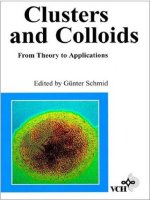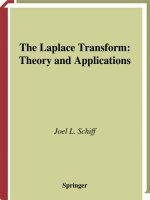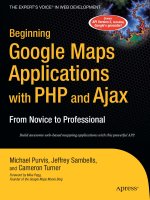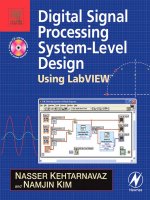microprocessor theory and applications with 68000 /68020 and pentium
Bạn đang xem bản rút gọn của tài liệu. Xem và tải ngay bản đầy đủ của tài liệu tại đây (24.63 MB, 590 trang )
Microprocessor
Theory
and Applications with
68000/68020
and Pentium
M.
RAFIQUZZAMAN,
Ph.D.
Professor
California State Polytechnic University
Pomona, California
and
President
Rafi Systems, Inc.
WILEY
A
JOHN
WILEY
&
SONS,
INC., PUBLICATION
This Page Intentionally Left Blank
Microprocessor Theory
and Applications with
68000/68020
and Pentium
This Page Intentionally Left Blank
Microprocessor
Theory
and Applications with
68000/68020
and Pentium
M.
RAFIQUZZAMAN,
Ph.D.
Professor
California State Polytechnic University
Pomona, California
and
President
Rafi Systems, Inc.
WILEY
A
JOHN
WILEY
&
SONS,
INC., PUBLICATION
Copyright
0
2008 by John Wiley
&
Sons, Inc. All rights reserved.
Published by
John
Wiley
&
Sons, Inc., Hoboken, New Jersey.
Published simultaneously in Canada.
No part of this publication may be reproduced, stored in a retrieval system,
or
transmitted in any form
or
by
any means, electronic, mechanical, photocopying, recording, scanning,
or
otherwise, except as permitted under
Section 107
or
108
of the 1976 United States Copyright Act, without either the prior written permission of the
Publisher,
or
authorization through payment of the appropriate per-copy fee to
the
Copyright Clearance Center,
Inc., 222 Rosewood Drive, Danvers, MA 01923, (978) 750-8400, fax (978) 750-4470,
or on
the web at
www.copyright.com. Requests to the Publisher for permission should be addressed to the Permissions
Department,
John
Wiley
&
Sons, Inc.,
11
1
River Street, Hoboken, NJ 07030, (201) 748-601 1, fax (201) 748-
6008,
or
online at
lgo/permission.
Limit of Liability/Disclaimer of Warranty: While the publisher and author have used their best efforts in
preparing this book, they make no representations
or
warranties with respect to the accuracy
or
completeness of
the contents of this book and specifically disclaim any implied warranties of merchantability
or
fitness
for
a
particular purpose.
No
warranty may be created
or
extended by sales representatives
or
written sales materials.
The advice and strategies contained herein may not be suitable for your situation.
You
should consult with a
professional where appropriate. Neither the publisher nor author shall be liable for any
loss
of profit
or
any
other commercial damages, including but not limited to special, incidental, consequential,
or
other damages.
For
general information on
our
other products and services
or
for technical support, please contact
our
Customer Care Department within the United States at
(800)
762-2974, outside the United States at (317) 572-
3993
or
fax (317) 572-4002.
Wiley also publishes its books in a variety of electronic formats. Some content that appears in print may not be
available in electronic format.
For
information about Wiley products, visit
our
web site at www.wiley.com.
Library
of
Congress Cataloging-in-Publication Data:
Rafiquzzaman, Mohamed.
Rafiquzzaman.
p. cm.
Microprocessor theory and applications with 68000/68020 and Pentium
/
M.
Includes bibliographical references and index.
ISBN 978-0-470-3803 1-4 (cloth)
1.
Motorola
68000
series microprocessors. 2. Pentium (Microprocessor) I.
Title.
QA76XM6895R34 2008
004.1654~22 2008011009
Printed in the United States of America.
10
9
8
7
6
5
4 3 2
1
To
my
wge,
Kusum;
my
son,
Tito;
and
my
brothel;
Elan
This Page Intentionally Left Blank
CONTENTS
PREFACE XI11
CREDITS
XV
1.
INTRODUCTION TO MICROPROCESSORS
1.1
Explanation
of
Terms
1.2
Microprocessor Data Types
1.2.1
Unsigned and Signed Binary Numbers
1.2.2
ASCII and EBCDIC Codes
1.2.3
Unpacked and Packed Binary-Coded-Decimal Numbers
1.2.4
Floating-point Numbers
1.3
Evolution
of
the Microprocessor
1.4
Typical Features
of
32-bit and 64-bit Microprocessors
1.5
Microprocessor-based System Design Concepts
1.6
Typical Microprocessor Applications
1.6.1
A Simple Microprocessor Application
1.6.2
Examples
of
Typical Microprocessor Applications
2.
MICROCOMPUTER ARCHITECTURE
2.1
Basic Blocks
of
a Microcomputer
2.2
Typical Microcomputer Architecture
2.2.1
System Bus
2.2.2
Clock Signals
2.3
Single-Chip Microprocessor
2.3.1
Register Section
2.3.2
Control Unit
2.3.3
Arithmetic-Logic Unit
2.3.4
Functional Representations
of
Simple and Typical Microprocessors
2.3.5
Simplified Explanation
of
Control Unit design
2.4
Program Execution by Conventional Microprocessors
2.5
Program Execution by typical 32-bit Microprocessors
2.5.1
Pipelining
2.5.2
Branch Prediction Feature
2.6
Scalar and Superscalar Microprocessors
2.7
RISC
vs.
CISC
Questions and Problems
1
2
4
5
7
7
8
9
15
16
19
20
21
23
23
24
24
25
26
26
30
32
32
34
38
38
39
44
45
45
47
vii
Vlll
3. MICROPROCESSOR MEMORY ORGANIZATION
3.1
Introduction
3.2
Main memory
3.2.1
Read-only Memory
3.2.2
Random-Access Memory
3.2.3
READ and WRITE Timing Diagrams
3.2.4
Main Memory Organization
3.2.5
Main Memory Array Design
3.3.1
Memory Management Concepts
3.3.2
Cache Memory Organization
4.
MICROPROCESSOR INPUT/OUTPUT
3.3
Microprocessor on-chip memory management unit and cache
Questions and Problems
4.1
Introduction
4.2
Simple I/O Devices
4.3
Programmed
I/O
4.4
Unconditional and Conditional Programmed
I/O
4.5
Interrupt
I/O
4.5.1
Interrupt Types
4.5.2
Interrupt Address Vector
4.5.3
Saving the Microprocessor Registers
4.5.4
Interrupt Priorities
4.6
Direct Memory Access (DMA)
4.7
Summary
of
I/O
Questions and Problems
5.1
Microcomputer Programming Languages
5.2
Machine Language
5.3
Assembly Language
5.
MICROPROCESSOR PROGRAMMING CONCEPTS
5.3.1
Types
of
Assemblers
5.3.2
Assembler Delimiters
5.3.3
Specifying Numbers by Typical Assemblers
5.3.4
Assembler Directives or Pseudoinstructions
5.3.5
Assembly Language Instruction Formats
5.3.6
Instruction Set Architecture (ISA)
5.3.7
Typical Instruction Set
5.3.8
Typical Addressing Modes
5.3.9
Subroutine Calls in Assembly Language
5.4
High-Level Language
5.5
Choosing a programming language
5.6
Flowcharts
Questions and Problems
6.1
Introduction
6.2 68000
Registers
6.3
68000
Memory Addressing
6.4
Assembly Language Programming with the
68000
6. ASSEMBLY LANGUAGE PROGRAMMING WITH THE 68000
Contents
49
49
50
51
52
52
54
55
58
58
63
68
71
71
72
74
76
78
80
80
81
81
84
86
87
89
89
90
90
91
92
93
93
95
97
98
102
104
104
105
106
107
109
109
111
112
113
Contents
ix
6.5 68000 Addressing Modes
6.5.1 Register Direct Addressing
6.5.2 Address Register Indirect Addressing
6.5.3 Absolute Addressing
6.5.4 Program Counter Relative Addressing
6.5.5 Immediate Data Addressing
6.5.6 Implied Addressing
6.6.1 Data Movement Instructions
6.6.2 Arithmetic Instructions
6.6.3 Logic Instructions
6.6.4 Shift and Rotate Instructions
6.6.5 Bit Manipulation Instructions
6.6.6 Binary-Coded-Decimal Instructions
6.6.7 Program Control Instructions
6.6.8 System Control Instructions
6.6.9 68000 Stack
6.6 68000 Instruction Set
6.7 68000 Delay Routine
Questions and Problems
117
117
118
122
123
124
125
125
128
134
150
152
156
157
160
163
166
168
170
7. 68000 HARDWARE AND INTERFACING
175
175
7.1.1 Synchronous and Asynchronous Control Lines
177
7.1.2 System Control Lines 179
7.1.4 DMA Control Lines 181
7.1.5 Status Lines 181
181
7.2.1 68000 Clock Signals 181
7.2.2 68000 Reset Circuit 182
7.3 68000 Read and Write Cycle Timing Diagrams
185
7.4 68000 Memory Interface 188
7.5 68000
I10
192
7.5.1 68000 Programmed
I10
192
7.5.3 68000 DMA 206
7.6 68000 Exception Handling 207
7.7 68000/2732/6116/682 1-Based Microcomputer 208
7.8 Multiprocessing with the 68000 Using the TAS Instruction and the
AS
Signal 212
Questions and Problems 217
221
7.1 68000 Pins And Signals
7.1.3 Interrupt Control Lines 181
7.2 68000 Clock and Reset Signals
7.5.2 68000 Interrupt System 201
8.
ASSEMBLY LANGUAGE PROGRAMMING WITH THE 68020
8.1
Introduction 22 1
8.2 68020 Functional Characteristics 222
8.3 68020 Registers 225
8.4 68020 Data Types, Organization, and CPU Space Cycle
227
8.5 68020 Addressing Modes
22 8
8.5.1 Address Register Indirect (AM) with Index and 8-Bit Displacement 23
1
8.5.2
ARI
with Index (Base Displacement, bd: Value
0
or 16 Bits or 32 Bits) 232
X
Contents
8.5.3 Memory Indirect 232
8.5.4 Memory Indirect with PC 233
8.6 68020 Instructions 237
8.6.1 68020 New Privileged Move Instructions
238
8.6.2 Return and Delocate Instruction 238
8.6.3 CHK/CHK2 and CMP/CMP2 Instructions 239
8.6.4 Trap-on-Condition Instructions 243
8.6.5 Bit Field Instructions 245
8.6.6 PACK and UNPK Instructions 247
8.6.7 Multiplication and Division Instructions 250
8.6.8 68000 Enhanced Instructions 254
8.6.9 68020 Subroutines 254
Questions and Problems 256
9. 68020 HARDWARE AND INTERFACING 261
9.1 Introduction 26 1
9.1.1 68020 Pins and Signals 26 1
9.1.2 68020 Dynamic Bus Sizing 265
9.1.3 68020 Timing Diagrams 27 1
9.2 68020 System Design 274
9.2.1 Memory Decode Logic for Memory and
VO
275
9.2.2 68020-27C256 Interface 276
9.2.3 68020-
2256C/CH
(SRAM) Interface 277
9.2.4 68020 Programmed I/O 279
9.3 68020 Exception processing 282
9.4 68020-based Voltmeter 283
285
289
a Seven-Segment Display 293
294
Segment Display 296
Questions and Problems 302
10. ASSEMBLY LANGUAGE PROGRAMMING WITH
THE
PENTIUM: PART 1
305
10.1 Introduction 306
10.2 Pentium Registers 308
10.2.1 General-Purpose Registers 308
10.2.2 Stack Pointers and Index Registers 308
10.2.3 Extended Instruction Pointer and Flag Register 310
10.2.4 Segment Registers 311
10.3 Modes of Operation 311
10.3.1 Real Mode 3 12
10.3.2 Protected Mode 315
10.4
Pentium data Organization 316
10.5 Assembly Language Programming with the Pentium
316
10.6 Pentium Addressing Modes 32 1
32 1
9.4.1 Voltmeter Design Using Programmed I/O
9.4.2 Voltmeter Design Using Interrupt I/O
9.5 Interfacing a 68020-Based Microcomputer to a Hexadecimal Keyboard and
9.5.1 Basics of Keyboard and Display Interface to a Microcomputer
9.5.2 68020 Interface to a Hexadecimal Keyboard and a Seven-
10.6.1 Pentium’s 32-Bit Addressing in Real Mode
Contents
xi
10.6.2 Register and Immediate Modes
323
10.6.3 Memory Addressing Mode
3 24
10.6.4 Port Addressing Mode 330
10.6.5 Relative Addressing Mode 330
10.6.6 Implied Addressing Mode 330
10.7 Pentium Instructions
33
1
10.7.1 Data Transfer Instructions 33
1
10.7.2 Arithmetic Instructions 340
Questions and Problems 3 62
11. ASSEMBLY LANGUAGE PROGRAMMING
WITH
THE
PENTIUM: PART 2 367
11.1 Logic, Bit Manipulation, Set on condition, Shift, and Rotate Instructions 367
1 1.3 Unconditional Transfer Instructions 3 82
11.4 Conditional Branch Instructions 389
11.5 Iteration Control Instructions
3
92
11.6 Interrupt Instructions 393
1
1.7 Processor Control Instructions 394
1
1.8 Pentium Delay routine
395
Questions and Problems 397
12. PENTIUM HARDWARE AND INTERFACING 401
40
1
403
405
12.3.1 Memory Interface 405
12.3.2 Pentium-EPROM Interface 41 1
12.3.3 Pentium-SRAM interface 413
12.3.4 Pentium Programmed
I/O
415
12.3.5 Pentium Interrupts and Exceptions in Real Mode
420
12.4 Pentium-based voltmeter 423
12.4.1 Pentium-based voltmeter using programmed
I/O
424
12.4.2 Pentium-based voltmeter using NMI
426
12.4.3 Pentium-based voltmeter using INTR
427
430
430
a Pentium-Based Microcomputer 43
1
APPENDIX A: ANSWERS TO SELECTED PROBLEMS
443
APPENDIX
B:
GLOSSARY 45
1
APPENDIX C: MOTOROLA 68000 AND SUPPORT CHIPS
467
APPENDIX D: 68000 EXECUTION TIMES
479
APPENDIX E: 68000
/
SELECTED 68020 INSTRUCTION SET 487
APPENDIX F: PENTIUM INSTRUCTION FORMAT AND TIMING 497
F. 1. INTEGER INSTRUCTION FORMAT AND TIMING 497
1 1.2 String Instructions 377
12.1 Pentium Pins and Signals
12.2 Pentium READ and WRITE Timing Diagrams
12.3 Pentium’s interface to memory and I/O
12.5 Interfacing a Pentium-based Microcomputer to a Hexadecimal Keyboard
and a Seven Segment Display
12.5.1 Basics of Keyboard and Display Interface to a Microcomputer
12.5.2 Hexadecimal Keyboard and Seven-Segment Display Interface to
Questions and Problems 437
xi
i
Contents
APPENDIX
G:
PENTIUM INSTRUCTION SET
IN
REAL
MODE (SELECTED)
525
APPENDIX
H:
PENTIUM PINOUT AND PIN DESCRIPTIONS
547
H.
1.
PentiumTM Processor Pinout
547
H.2.
Design Notes
55
1
H.3.
Quick Pin Reference
55 1
H.4.
PIN REFERENCE TABLES
558
H.5.
Pin Grouping According
To
Function
560
H.6.
Output Pin Grouping According
To
When Driven
561
BIBLIOGRAPHY 563
INDEX 565
PREFACE
Microprocessors play an important role in the design of digital systems. They are found in
a wide range of applications, such as process control and communication systems.
This book is written to present the fundamental concepts of assembly language
programming and system design concepts associated with typical microprocessors, such as
the Motorola 68000/68020 and Intel Pentium. The 68000 is a 16-bit microprocessor that
continues to be popular. Since the 68000 uses linear memory and contains 32-bit general-
purpose registers, it is an excellent educational tool for acquiring an understanding of both
hardware and software aspects of typical microprocessors.
Conventional microprocessors such as the 68000 complete fetch, decode and
execute cycles of an instruction in sequence. Typical 32-bit microprocessors such as
the 68020 and Pentium use pipelining, in which instruction fetch and execute cycles are
overlapped. This speeds up the instruction execution time of 32-bit microprocessors.
Pipelining was used for many years in mainframe and minicomputer CPUs. In addition,
other mainframe features, such as memory management and floating-point and cache
memory, are implemented in 32-bit microprocessors. Hence, brief coverage
of
these topics
is provided in the first part of the book.
The book is self-contained and includes a number of basic topics. A basic
digital logic background is assumed. Characteristics and principles common to typical
microprocessors are emphasized and basic microcomputer interfacing techniques are
demonstrated via examples using the simplest possible devices, such as switches, LEDs,
A/D
converters, the hexadecimal keyboard, and seven-segment displays.
The book has evolved from classroom notes developed for three microprocessor
courses taught at the Electrical and Computer Engineering Department, California State
Poly University, Pomona for the last several years: ECE 343 (Microprocessor
I),
ECE 432
(Microprocessor 11), and ECE 56 1 (Advanced Microprocessors).
The text is divided into 12 chapters. In Chapter 1, we provide a review of
terminology, number systems, evolution of microprocessors, system design concepts and
typical microprocessor applications.
Chapters 2 through 12 form the nucleus of the book. Chapter 2 covers typical
microcomputer architectures for both 16-bit (conventional) and 32-bit microprocessors.
The concepts of pipelining, superscalar processors and RISC vs. CISC are included.
XI11
xiv
Preface
Chapter
3
is focused on the memory organization of typical microprocessors. The
basic concepts associated with main memory array design, including memory maps are
also covered, as are memory management concepts and cache memory organization.
In Chapter
4,
we describe microprocessor input/output techniques including
programmed I/O, interrupt I/O, and direct memory access (DMA).
Chapter
5
contains programming concepts associated with atypical microprocessor.
Topics include assembly language programming, typical addressing modes, and instruction
sets.
The theory of assembly language programming and system design concepts
covered in the early chapters
is
illustrated in Chapters 6 through 12 by means of a typical
conventional 16-bit microprocessor such as the Motorola 68000 and typical 32-bit
microprocessors such as the Motorola 68020 and Intel Pentium. Several examples of
assembly language programming and
I/O
techniques associated with these microprocessors
are included. These chapters also demonstrate how the software and hardware work
together by interfacing simple
I/O
devices such as LEDs, a hexadecimal keyboard, and
A/D
converters. The concepts are described in a very simplified manner.
A CD containing a step-by-step procedure for installing and using a typical
68000/68020 assembleddebugger such as the ide68k21 and a Pentium assembler/
debugger such as the MASM32
/
OllyDebugger is provided. Note that these assemblers
and debuggers are Windows-based and are very user friendly. Screen shots provided on
the CD verify the correct operation of several assembly language programs for the 68000,
68020, and Pentium via simulations using test data.
The book can be used in a number of ways. Since the materials presented here
are basic and do not require an advanced mathematical background, the book can easily be
adopted as a text for
two-
semester courses in microprocessors taught at the undergraduate
level in electrical/computer engineering and computer science departments.
The book will also be useful for graduate students and for practicing microprocessor
system designers. Practitioners of microprocessor system design will find more simplified
explanations, together with examples and comparison considerations, than are found in
manufacturers’ manuals.
I wish to extend my sincere appreciation to my students, Joseph Lee, Raffi
Karkourian, Tony Lopez, Julius Ramos, David Ambasing, Kevin Asprer, William Cambell,
Devine Jeyarajah, Huy Nguyen, Thuan
Ho,
Kenneth Kha, Darren Ly, Dat Nguy, and Sevada
Isayan for reviewing the manuscript and making valuable comments, and to CJ Media of
California for preparing the final version of the manuscript.
I
am indebted especially to my
deceased parents, who were primarily responsible for my accomplishments.
Pomona,
California
M.
RAFIQUZZAMAN
CREDITS
The material cited here is used by permission of the sources listed below.
Copyright of Freescale Semiconductor, Inc. 2008, Used by Permission: Table 6.4, Table
7.1, Table 7.2, Table 7.3, Table 7.5, Tables 7.7 through 7.11, Tables 8.2 through 8.13,
Tables 9.1 through 9.7, Tables 9.1 1 and 9.12, Table 10.21, Table 10.23, Figures 6.1 through
6.3, Figure 7.1, Figure 7.2, Figure 7.8, Figure 7.12, Figure 7.14, Figures 8.1 through 8.3,
Figures 9.1 through 9.5, Figures 9.9(a) and 9.9(b), Figures 9.16 through 9.20, Appendix
C, Appendix D. All mnemonics of Motorola microprocessors are courtesy of Freescale
Semiconductor, Inc.
Copyright of Intel Corporation, Used by Permission: Table 10.5, Table 10.6, Tables 11.2
through 11.5, Table 11.7, Tables 12.1 through 12.8, Table 12.10, Table 12.12, Figure 2.9(b),
Figure 10.1, Figure 10.2, Figure 10.5, Figures 1
1.1
through
1
1.4, Figures 12.1 through
12.6, Figure 12.12, Appendix F, Appendix
H.
All mnemonics of Intel microprocessors are
courtesy of Intel Corporation. The 80386 microprocessor referred to in the text as the
i386TM, the 80486 as the i486TM, and the Pentium as the PentiumTM, trademarks of Intel
Corporation.
Microsoft: MASM32 software used by permission.
Oleh Yuschuk, The author
of
OllyDbg: OllyDbg software used by permission.
Peter
J.
Fondse, The author of Ide 68k: Ide 68k software used by permission.
xv
This Page Intentionally Left Blank
1
INTRODUCTION TO
MICROPROCESSORS
Digital systems are designed to store, process, and communicate information in digital form.
They are found in a wide range of applications, including process control, communication
systems, digital instruments, and consumer products. A digital computer, more commonly
called simply a
computer,
is an example of a typical digital system.
A computer manipulates information in digital or more precisely, binary form. A
binary
number
has only
two
discrete values: zero or one. Each discrete value is represented
by the
OFF
and
ON
status of an electronic switch called a
transistor.
All computers
understand only binary numbers. Any decimal number (base
10,
with ten digits from
0
to
9)
can be represented by a binary number (base
2,
with digits
0
and
1).
The basic blocks of a computer are the central processing unit (CPU), the
memory, and the input/output
(UO).
The CPU of a computer is basically the same as the
brain of a human being;
so
computer memory is conceptually similar to human memory.
A question asked of a human being is analogous to entering a program into a computer
using an input device such as a keyboard, and a person answering a question is similar
in concept to outputting the program result to a computer output device such as a printer.
The main difference is that human beings can think independently, whereas computers can
only answer questions for which they are programmed. Computer
hardware
includes such
components as memory, CPU, transistors, nuts, bolts, and
so
on. Programs can perform a
specific task, such as addition, if the computer has an electronic circuit capable of adding
two
numbers. Programmers cannot change these electronic circuits but can perform tasks
on them using instructions.
Computer
software
consists of a collection of programs that contain instructions
and data for performing a specific task. All programs, written using any programming
language (e.g., C++), must be translated into binary prior to execution by a computer
because the computer Therefore, a translator is
necessary to convert such a program into binary and this is achieved using a translator
program called a
compiler.
Programs in the binary form of
1’s
and
0’s
are then stored
in the computer memory for execution. Also, as computers can only add, all operations,
including subtraction, multiplication, and division, are performed by addition.
Due to advances in semiconductor technology, it is possible to fabricate a CPU
on a single chip. The result is a
microprocessor.
Both metal-oxide semiconductor (MOS)
and bipolar technologies are used in the fabrication process. The CPU can be placed on
a single chip when MOS technology is used. However, several chips are required with
bipolar technology. At present, HCMOS (high-speed complementary MOS) or BICMOS
understands only binary numbers.
2
Microprocessor Theory and Applications with
68000/68020
and Pentium
(combination of bipolar and HCMOS) technology
to fabricate a
microprocessor on a single chip. Along with the microprocessor chip, appropriate memory
and I/O chips can be used to design a microcomputer. The pins on each one of these chips
can be connected to the proper lines on a system bus, which consists of address, data, and
control lines. In the past, some manufacturers designed a complete microcomputer on a
single chip with limited capabilities. Single-chip microcomputers were used in a wide
range of industrial and home applications.
Microcontrollers evolved from single-chip microcomputers. Microcontrollers are
typically used for dedicated applications such as automotive systems, home appliances, and
home entertainment systems. Typical microcontrollers include a microcomputer, timers,
and A/D (analog-to- digital) and D/A (digital to analog) converters, all on a single chip.
Examples of typical microcontrollers are the Intel 875 1 (8-bit)/8096 (16-bit), Motorola
HC 1 1 (8-bit)/HC 16 (1 6-bit), and Microchip Technology’s PIC (peripheral interface
controller).
In this chapter we first define some basic terms associated with microprocessors.
We then describe briefly the evolution of microprocessors and typical features of 32- and
64-bit microprocessors. Finally, microprocessor-based system design concepts and typical
microprocessor applications are included.
is normally used
1.1
Explanation
of
Terms
Before we go on, it is necessary to understand some basic terms.
An Address is a pattern of
0’s
and 1 ’s that represents a specific location in memory
or a particular I/O device. Typical 8-bit microprocessors have 16 address lines, and,
these 16 lines can produce 216 unique 16-bit patterns from
0000000000000000
to
11 11
1
1
11
1
11 11 11 1, representing 65,536 different address combinations.
Addressing mode is the manner in which the microprocessor determines the operand
(data) and destination addresses during execution of an instruction.
An Arithmetic-logic unit (ALU) is a digital circuit that performs arithmetic and logic
operations on two n-bit digital words. The value of n can be 4,
8,
16, 32, or 64.
Typical operations performed by an ALU are addition, subtraction, ANDing, ORing,
and comparison of two n-bit digital words. The size of the ALU defines the size of the
microprocessor. For example, a 32-bit microprocessor contains a 32-bit ALU.
Bit is an abbreviation for the term binary digit. A binary digit can have only two values,
which are represented by the symbols
0
and 1, whereas a decimal digit can have 10
values, represented by the symbols
0
through 9. The bit values are easily implemented
in electronic and magnetic media by two-state devices whose states portray either of
the binary digits
0
and 1. Examples of such two-state devices are a transistor that is
conducting or not conducting, a capacitor that is charged or discharged, and a magnetic
material that is magnetized north to south or south to north.
Bit size refers to the number of bits that can be processed simultaneously by the basic
arithmetic circuits of a microprocessor.
A
number of bits taken as a group in this
manner is called a word. For example, a 32-bit microprocessor can process a 32-bit
word. An 8-bit word is referred to as a byte
,
and a 4-bit word is known as a nibble.
A bus consists of a number of conductors (wires) organized to provide a means of
communication among different elements in a microprocessor system. The conductors
Introduction to Microprocessors
3
in a bus can be grouped in terms of their functions. A microprocessor normally has
an address bus, a data bus, and a control bus. Address bits are sent to memory or to
an external device on the
address bus.
Instructions from memory, and data to/from
memory or external devices, normally travel on the
data bus.
Control signals for the
other buses and among system elements are transmitted on the
control bus.
Buses are
sometimes
bidirectional;
that is, information can be transmitted in either direction on
the bus, but normally in only one direction at a time.
Cache
Memory is a high-speed, directly accessible, relatively small, semiconductor
readwrite memory block used to store datdinstructions that the microprocessor may
need in the immediate future. It increases speed by reducing the number of external
memory reads required by the microprocessor. Typical 32-bit microprocessors such as
the Intel Pentium are provided with on-chip cache memory. Pentium I1 supports two
levels of cache. These are L1 (Level
1
cache) and L2 (Level 2 cache) cache memories.
The L1 cache (smaller in size) is contained inside the microprocessor while L2 cache
(larger in size) is interfaced to the microprocessor. This
two
level cache enhances the
performance of the microprocessor.
A
Complex Instruction Set Computer
(CISC) contains a large instruction set. It
is
difficult to pipeline compared to
RISC.
Motorola 68020
is
a CISC microprocessor.
Clock
is analogous to human heart beats. The microprocessor requires synchronization
among its components, and this is provided by a
clock
or timing circuits.
The
instruction set
of a microprocessor
is
a list of commands that the microprocessor
is
designed to execute. Typical instructions are ADD, SUBTRACT, and STORE.
Individual instructions are coded as unique bit patterns which are recognized and
executed by the microprocessor. If a microprocessor has
3
bits allocated to the
representation of instructions, the microprocessor will recognize a maximum of 23, or
eight, different instructions. The microprocessor will then have a maximum of eight
instructions in its instruction set. It is obvious that some instructions will be more
suitable than others to a particular application. For example, if a microprocessor
is
to be
used in a calculating mode, instructions such as ADD, SUBTRACT, MULTIPLY, and
DIVIDE would be desirable. In a control application, instructions inputting digitized
signals to the processor and outputting digital control variables to external circuits
are essential. The number of instructions necessary in an application will directly
influence the amount of hardware in the chip set and the number and organization of
the interconnecting bus lines.
Memoly Management Unit (MN)
allows programmers to write programs much
larger than could fit in the main memory space available to the microprocessor. The
programs are simply stored in a secondary device such as a hard disk and portions
of
the programs are swapped into the main memory as needed for execution by
the microprocessor. The MMU is implemented as on-chip hardware in typical
microprocessors such as the Pentium.
A
microprocessor
is the CPU of a microcomputer contained on a single chip, and
must be intefaced with peripheral support chips in order to function. In general, a CPU
contains several
registers
(memory elements), an ALU, and a control unit. Note that
the control unit translates instructions and performs the desired task. The number of
peripheral devices depends on the particular application involved and may even vary
within an application. As the microprocessor industry matures, more of these functions
Microprocessor Theory and Applications with
68000/68020
and Pentium
are being integrated onto chips, to reduce the system package count. In general, a
microcomputer
typically consists of a microprocessor
(CPU)
chip, input and output
chips, and memory chips in which programs (instructions and data) are stored. Note
that a
microcontroller,
on the other hand, is implemented on a single chip containing
typically a
CPU,
memory,
I/O,
a timer, and A/D and
D/A
converter circuits.
Pipelining
is a technique that overlaps instruction fetch (instruction read) with
execution. This allows a microprocessor’s processing operation to be broken down into
several steps (dictated by the number of pipeline levels or stages)
so
that the individual
step outputs can be handled by the microprocessor in parallel. Pipelining is often used
to fetch the microprocessor’s next instruction while executing the current instruction,
which speeds up the overall operation of the microprocessor considerably.
Random-access memory
(RAM)
is a storage medium for groups of bits or words
whose contents cannot only be read but can also be altered at specific addresses. A
RAM
normally provides
volatile storage,
which means that its contents are lost in case
power is turned
off.
RAMs
are fabricated on chips and have typical densities of 4096
bits to 1 megabit per chip. These bits can be organized in many ways: for example,
as 4096-by-1-bit words or as 2048-by-%bit words.
RAMs
are normally used for the
storage
of
temporary data and intermediate results as well as programs that can be
reloaded from a backup nonvolatile source.
RAMs
are capable of providing large
storage capacity, in the megabit range.
Read-only memory
(ROM)
is a storage medium for the groups of bits called
words,
and its contents cannot normally be altered once programmed. A typical
ROM
is
fabricated on a chip and can store, for example, 2048 eight-bit words, which can be
accessed individually by presenting to it one of 2048 addresses. This
ROM
is referred
to as a
2K
by 8-bit
ROM.
101 101 11 is an example of an 8-bit word that might be stored
in one location in this memory. A
ROM
is a
nonvolatile storage
device, which means
that its contents are retained in case power is turned
off.
Because of this characteristic,
ROMs
are used to store programs (instructions and data) that must always be available
to the microprocessor.
A
register
can be considered as volatile storage for a number of bits. These bits may
be entered into the register simultaneously (in parallel) or sequentially (serially) from
right to left or from left to right, 1 bit at a time. An 8-bit register storing the bits
1 1
1
10000 is represented as follows:
1~1~1~1~0~0~0~0
A
reduced instruction set computer
(RISC)
contains a simple instruction set. The
RISC
architecture maximizes speed by reducing clock cycles per instruction and
makes it easier to implement pipelining. A Power
PC
is a
RISC
microprocessor.
A
Superscalar
microprocessor is provided with more than one pipeline and can
execute more than one instruction per clock cycle. The Pentium is a superscalar
microprocessor.
1.2
Microprocessor Data Types
In this section we discuss data types used by
typical microprocessors: unsigned and
Introduction
to
Microprocessors
5
signed binary numbers, binary-coded decimal (BCD), ASCII (American Standard Code
for Information Interchange), EBCDIC (extended binary coded decimal interchange code),
and floating-point numbers.
1.2.1
An
Unsigned binary number
has no arithmetic sign, therefore, are always positive. Typical
examples are your age or a memory address, which are always positive numbers. An 8-bit
unsigned binary integer represents all numbers from
00,,
through FF,,(O,, through 255,,).
A
signed binary number,
on the other hand, includes both positive and negative
numbers. It is represented in the microprocessor in two’s-complement form. For example,
the decimal number +15 is represented in 8-bit two’s-complement form as
0000
1111
(binary) or OF (hexadecimal). The decimal number -15 can be represented in 8-bit
two’s-
complement form as
11
110001 (binary) or F1 (hexadecimal). Also, the most significant bit
(MSB) of a signed number represents the sign of the number. For example, bit
7
of an 8-bit
number, bit 15 of a 16-bit number, and bit 3
1
of a 32-bit number represent the signs of the
respective numbers. A
“0”
at the MSB represents a positive number; a “1” at the MSB
represents a negative number. Note that the 8-bit binary number 11 11 11 11
is
255,,when
represented as an unsigned number. On the other hand, 1 1 1 1 1 1 1 1 is
-
1
,,
when represented
as a signed number.
An error (indicated by overflow in a microprocessor) may occur while performing
twos complement arithmetic. The microprocessor automatically sets an overflow bit to
1 if the result of an arithmetic operation is too big for the microprocessor’s maximum
word size; otherwise it is reset to
0.
For signed arithmetic operations such as addition, the
overflow,
V
=
C,O
C,
where C, is the final carry and C, is the previous carry. This can be
illustrated by the following examples.
Consider the following examples for 8-bit numbers. Let
C,
be the final carry (carry
out of the most significant bit or sign bit) and C, be the previous carry (carry out of bit 6
or seventh bit).
We
will show by means of numerical examples that as long as C, and C,
are the same, the result is always correct. If, however, C, and C, are different, the result is
incorrect and sets the overflow bit to
1.
Now, consider the following cases.
Unsigned and Signed Binary Numbers
Case 1: C, and C, are the same.
00000110 0616
00010100
-16
/o
00011010 1.416
Cr=O
AJ
+
cp=
0
01101000 68
16
/l 01100010 62
16
11111010
-16
Cr=l
fw
+
cp=
1
Therefore when C, and C, are either both
0
or
both 1, a correct answer is obtained.
6
Microprocessor Theory and Applications with
68000/68020
and Pentium
Case
2:
C, and C, are different.
01011001
5916
nll)ol)ll)1
a6
c,= 1
C,
=
0
and C,
=
1 give an incorrect answer because the result shows that the
addition of
two
positive numbers is negative.
c,=
0
C,
=
1 and C,
=
0
provide an incorrect answer because the result indicates that the
addition of
two
negative numbers
is
positive. Hence, the overflow bit will be set to zero if
the carries C, and
C,
are the same, that is, if both C, and C, are either
0
or 1. On the other
hand, the overflow flag will be set to 1 if carries C, and C, are different. The relationship
among
C,
,
C,
,
and V can be summerized in a truth table as follows:
Inputs output
Cf
c,
V
00
0
01 1
10 1
11
0
From the truth table, overflow, V
=
c,
C,
+
C,
cp
=
C,
0
C,
Note that the symbol
0
represents exclusive-OR logic operation. Exclusive-OR
means that when two inputs are the same (both one or both zero), the output is zero. On the
other hand, iftwo inputs are different, the output is one. The overflow can be considered as
an output while C, and C, are the
two
inputs. The answer is incorrect when the overflow
bit is set to 1; the answer is correct if the overflow bit is
0.
multiplication
and division instructions as follows:
MULU
(multiply
two
unsigned numbers),
MULS
(multiply two signed numbers), DIW (divide
two
unsigned numbers), and DIVS (divide
two signed numbers). It is important for the programmer to understand clearly how to use
these instructions.
Typical microprocessors have separate unsigned and signed






![heuristic search [electronic resource] theory and applications](https://media.store123doc.com/images/document/14/y/sa/medium_8Qr1eazZIA.jpg)
![data visualization with flash builder [electronic resource] designing ria and air applications with remote data sources](https://media.store123doc.com/images/document/14/y/tf/medium_tfh1401469892.jpg)

